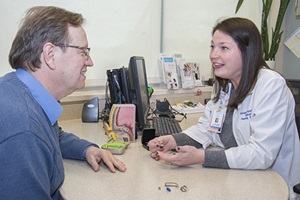About Hearing Aids and Listening Devices
TriHealth audiologists can help you with various types of hearing aids, ear pieces, ear protection and other electronic hearing devices. They also handle repairs for the hearing aids they fit.
Types of Hearing Aids
 Custom hearing aids
Custom hearing aids
Custom hearing aids are made specifically to fit your ears. The audiologist will make an impression of your ears to send to the manufacturer, where the hearing aid is made and sent to our office ready for programming. Custom styles include:
- Invisible: Hearing aids rest in the second bend of the ear canal where no one can see them. Ear canal size is a limitation.
- Completely-in-the-Canal (CIC): Hearing aids are seated deeply inside the ear canal. The faceplate is at the opening of the ear canal, making them virtually invisible.
- In-the-Canal (ITC): Hearing aids are seated in the ear canal and the lower half of the bowl of the outer ear.
- In-the-Ear (ITE): Hearing aids are seated in the ear canal and fill the entire outer portion of the ear.
Behind-the-ear hearing aids
Behind-the-ear (BTE) hearing aids sit behind the ear and have different tubing and earpiece options. Your audiologist will discuss with you which would be appropriate based on your hearing loss. BTE styles include:
- Receiver-in-the-Canal (RIC): Hearing aids are seated behind the ear, connecting to a receiver wire that connects to a small dome-like earpiece. The receiver wire sits flush with the skin and is aesthetically pleasing. Standard Behind-the-Ear (BTE): Hearing aids are seated behind the ear and connect to a tube with a custom-made earpiece.
Hearing Aid Repairs
Like any electrical device, hearing aids require maintenance. Maintaining the functionality of a hearing aid begins with you.
Daily cleaning of your hearing aids is very important and is something that your audiologist will show you how to do when you first get them. Different styles of hearing aids require different methods of cleaning. Using the correct procedures and the correct tools will help extend the life of the hearing aids.
It is also very important to keep your hearing aids dry. Do not ever use water to clean your hearing aids.
Despite regular cleaning, sometimes repairs are needed. If the hearing aid must be returned to the manufacturer for a repair and is within the warranty period, there will be no cost to you for the repair. If the hearing aids are out of the warranty period, your audiologist will discuss the cost associated with the repair with you.
Custom Ear Pieces for Swimmers, Musicians, Noise Protection
To make an ear piece, a small foam block is inserted into your ear canal to protect your eardrum. Putty-like material is then pushed into your ear canal, filling the space completely. This material hardens and is easily removed. This creates a mold of your ear canal and outer ear that an outside ear mold laboratory will use to make your devices. Types of ear pieces include:
- Swimmer’s ear: Pieces help keep your ears dry, but may also be used to decrease direct exposure to environmental noise. Many color combinations are available.
- Musician ear: Pieces protect your hearing by using sound filters that give you the ability to hear the specific frequency response of your music at a lower volume.
- Personal listening: Ear pieces can be custom-made to directly connect you to your personal devices, such as a cellphone, computer or for music. These custom earpieces are made to fit the shape of your ear and will not fall out during activity. The earpieces can be made in different colors.
- Hearing protection: Ear pieces are used by people subjected to extreme noise levels through employment or hobbies. This may include concerts, hunting, motorcycling or machinery. Different levels of sound dampening can be chosen.
Wireless Connectivity
Hearing aids can now be used to stream phone calls, music and messages directly from your smart phone or computer. This provides effortless transitions as you go about your day, providing the volume and clarity often missing for those with hearing loss.
Devices are also available for those not wearing hearing aids but who desire the same wireless connections. The Bragi Dash is a custom-made set of earpieces that provide wireless connections to smart phones and music. For more active users, the Activity Tracker helps you keep track of your performance.